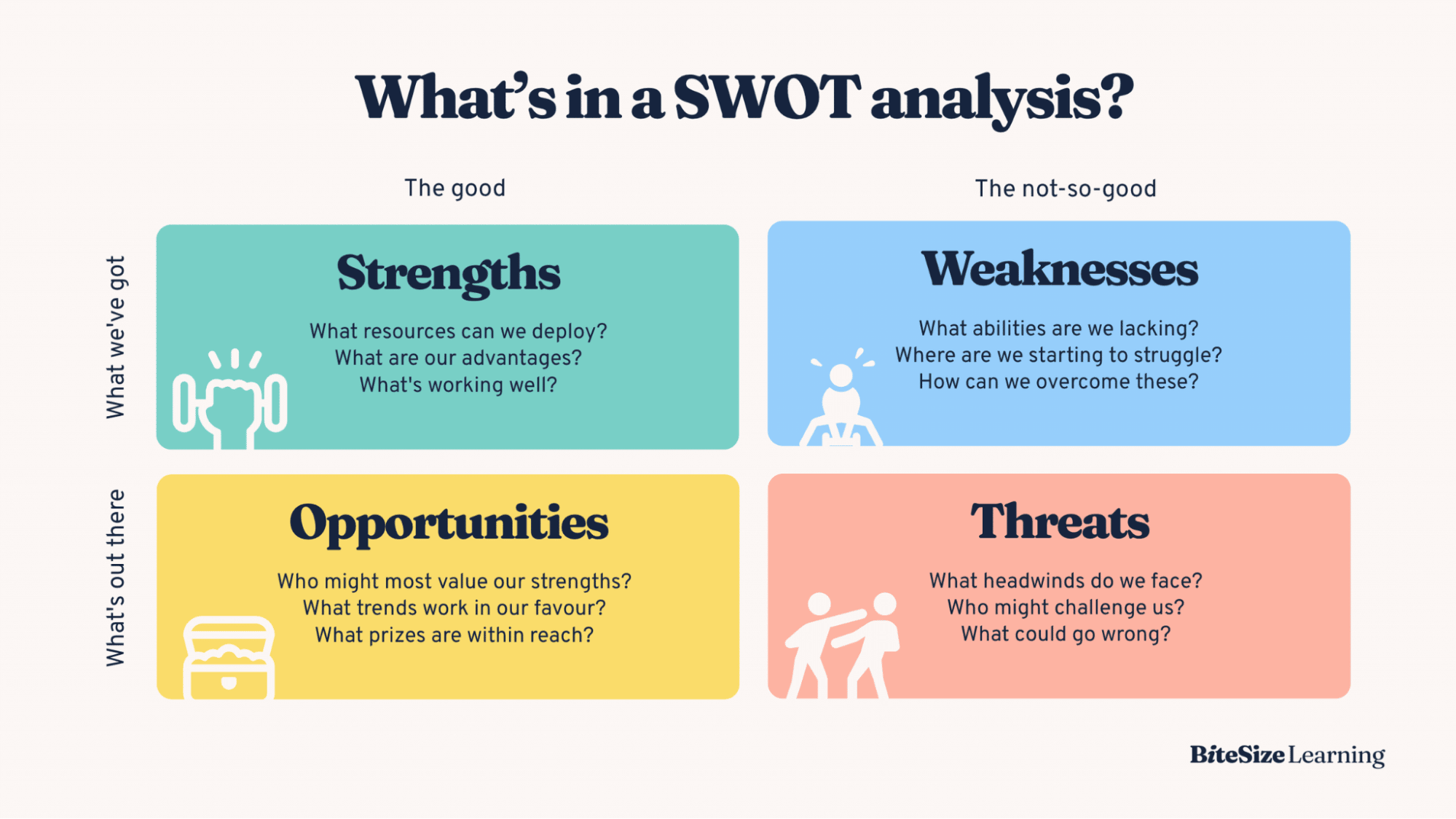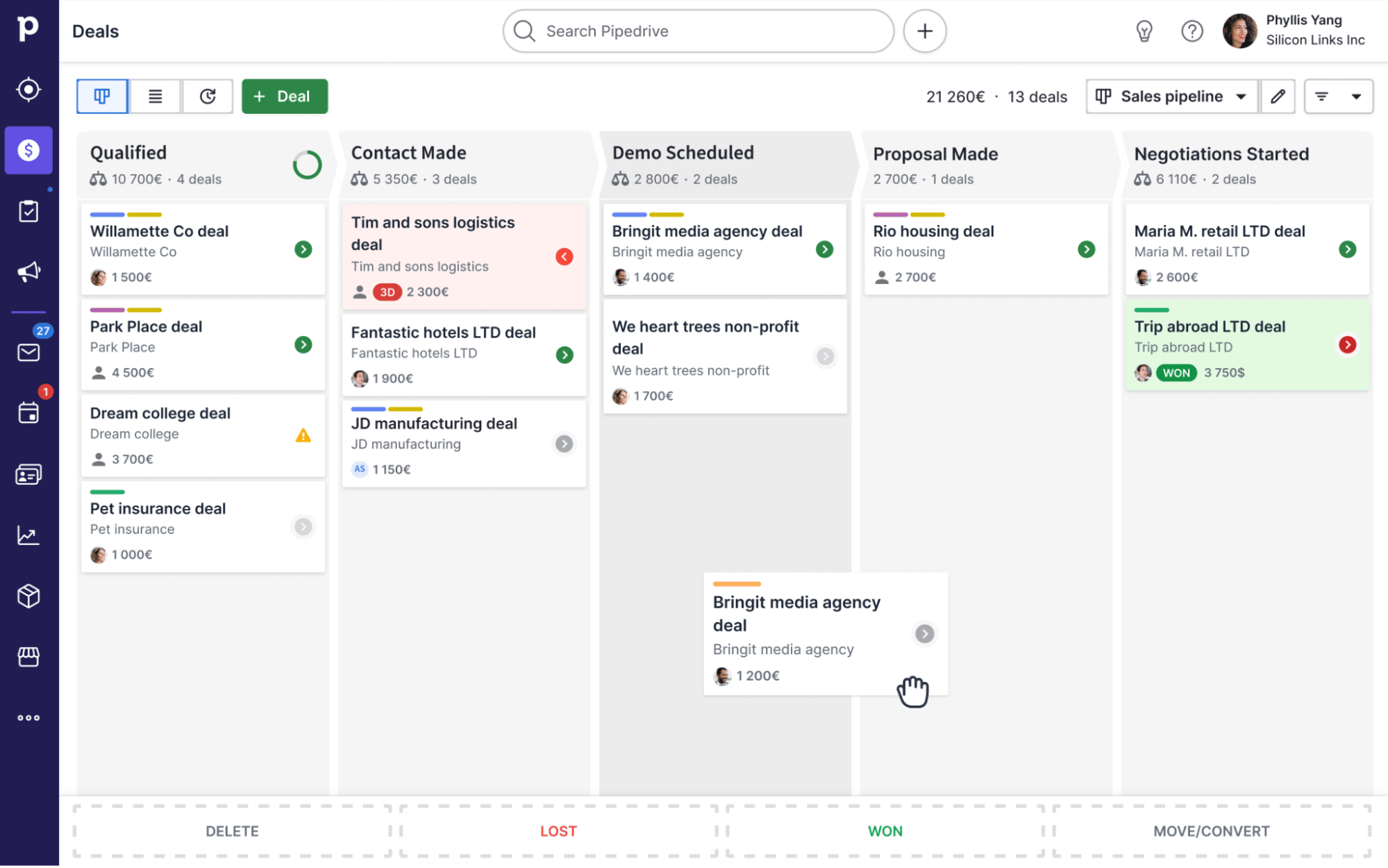Our view at Stack - Pipedrive is a robust CRM platform, offering automation, contact data collection, webhooks, AI-powered sales assistant, email communications, email marketing, and customisable sales pipeline workflows.
You’re constantly juggling growth, performance and efficiency as a business leader.
A clear organizational strategy can focus your efforts, optimize resources and align your team to achieve its goals.
In this article, you’ll learn how to choose and execute an organizational strategy that creates tangible results for your business.
What is an organizational strategy?
“Organizational strategy” definition
The plan and actions that guide businesses toward their long-term goals, ensuring resources and operations align along the way.
Different types of organizational strategies exist depending on your growth stage and specific objectives. For example, you may prioritize market expansion, product development or operational efficiency.
Businesses create organizational strategies to align their resources, operations and efforts with an overarching vision. Usually, this is to grow sustainably or gain a competitive advantage.
Let’s say you’re a startup that sells accounting software. You may create a differentiation strategy to help you stand out in a crowded market.
You may also develop a competitive strategy to target competitors’ weaknesses, capture market share and establish your new brand as a compelling alternative solution.
Before diving into the different strategy types, let’s explore why companies create them.
Recommended reading

Developing a pricing strategy: methods and examples
What are the benefits of organizational strategies for businesses?
Organizational strategies keep teams on the same page while working to drive sales and grow the company.
Here are some reasons businesses use this type of strategic planning.
Provides a defined roadmap for future actions
An organizational strategy outlines clear steps and plans for achieving business and performance objectives. These building blocks ensure each team’s efforts align with the broader company’s goals.
Let’s say you task your marketing team with developing a defensive strategy to protect your company’s brand positioning. Your finance team needs to be aware of this so they can allocate resources to ensure financial stability while supporting that strategy.
A defined, coordinated approach leads to better decision-making and keeps teams working toward the same objective without conflict.
Optimizes resources
Organizational strategies ensure you use resources (e.g., time, money and team members) efficiently and effectively.
According to McKinsey research, insufficient resources are the top cited challenge to increasing organizational efficiency.
Survey respondents say they don’t have enough resources to increase organizational efficiency.
Challenges to increasing efficiency in organizations, % of respondents (n=838)
A defined plan means you can focus on high-impact activities that will tangibly benefit your business and ensure everyone has what they need to achieve them.
Helps you stay competitive
An organizational strategy allows your company to consider and adapt to market changes to outperform competitors.
For example, 81% of shoppers want to buy environmentally sustainable products. However, they believe brands should make “greener” choices more available and affordable.
Keeping track of these insights can help attract more customers, drive sales and increase your market share. Constantly improving your processes and services helps your business stay relevant and dominant.
Promotes sustainable growth and development
Organizational strategies support long-term success as you work to develop your business continually.
For example, one academic paper found that engaging in corporate social responsibility (CSR) strategies (e.g., enhancing product sustainability) helped companies reduce the impacts of external risks like economic downturns.
The same paper found that adopting these mindful strategies can also increase product differentiation, allowing businesses to benefit from higher profit margins.
Recommended reading

What is sales efficiency? Definition, metrics and strategies
6 types of organizational strategies for businesses
You can categorize organizational strategies and initiatives based on your company’s focus and direction.
Here are six types of organization strategies and when you should implement them.
1. Corporate strategy
A corporate-level strategy is a plan that outlines your company’s overall direction, which markets you want to compete in and how you’ll allocate resources.
It aligns your entire organization toward common goals and helps you manage risk by identifying potential challenges and creating proactive solutions.
Here are three main types of corporate strategies:
-
Growth strategy. Expanding your business through mergers, acquisitions, product development, market penetration or diversification.
-
Stability strategy. Maintaining status and avoiding excessive risk when satisfied with your current performance or the stable external environment.
-
Retrenchment strategy. Reducing the scale or scope of your business to improve financial stability (e.g., downsizing or liquidation).
Your corporate-level strategy defines what niche markets your company should be involved in and how you fit into the broader landscape.
For example, Microsoft has used its growth strategy to diversify its offerings and position itself as one of the dominant players in corporate technology. The company operates in cloud computing (e.g., Microsoft Azure), productivity software (e.g., Teams) and operating systems (e.g., Windows).
Review and adjust your corporate strategy regularly to stay current with market shifts and new opportunities. Flexibility is critical to long-term success.
Recommended reading

6 key lessons for scaling your business globally (and quickly)
2. Business strategy
A business-level strategy outlines how you’ll compete effectively in your niches. Creating this type of strategy helps you focus on competitive strengths and how you can meet customer needs.
Three of the main types of business strategies include:
-
Cost leadership strategy. Gaining a competitive advantage by offering products or services at a lower price than others in your niche.
-
Differentiation strategy. Offering “unique” products or services based on quality, innovation, brand or customer service.
-
Focus strategy. Concentrating on a specific niche or market segment with one of the above strategies to achieve a competitive advantage.
Let’s stick with Microsoft as our example.
Microsoft’s differentiation strategy for its Teams product emphasizes seamless integration across devices and platforms to facilitate collaboration and productivity. The company sets itself apart by offering reliable, user-friendly tools and continuous updates.
In your business strategy, focus on your unique strengths and continuously assess others in your niche. Tailor your strategy to anticipate and meet customer wants and pain points.
3. Functional strategy
A functional-level strategy is a plan for managing specific departments or business units within your company (e.g., marketing or finance). Segmenting strategies for these departments ensures each operates efficiently and supports your overall business goals.
Here are four typical types of functional strategies:
-
Sales strategy. Increasing revenue through sales (e.g., customer acquisition, sales process optimization, relationship management and forecasting).
-
Marketing strategy. Effectively marketing products or services using segmentation, targeting, positioning and marketing mix (product, price, place, promotion).
-
Operations strategy. Efficiently producing and delivering products or services (e.g., supply chain management, quality control and resource allocation).
-
Human resources strategy. Managing people to achieve organizational goals (e.g., recruitment, training, personnel management and employee retention).
For example, Microsoft’s marketing strategy heavily invests in targeted digital campaigns (e.g., LinkedIn ads to reach professionals) and comprehensive content marketing efforts (e.g., blog posts and whitepapers on Azure and Office 365).
The company also leverages industry events like Microsoft Ignite to showcase its new technologies and engage directly with customers.
Its approach supports the wider business by reaching more customers, boosting product use and strengthening the Microsoft brand.
When creating your own functional strategies, ensure you align them with your business objectives. Consider cross-department collaboration (e.g., sales and marketing) to maximize efficiency and drive more impactful results.
Recommended reading

Create an effective marketing automation strategy and improve your ROI
4. Innovation strategy
An innovation strategy defines how your company will develop new products, services or processes. Successfully implementing this strategy can help your company drive growth and stay competitive.
Here are three types of innovation strategies you could pursue:
-
Product innovation strategy. Developing new or improved products to meet changing customer needs or create new markets.
-
Process innovation strategy. Improving the efficiency or effectiveness of production and delivery processes.
-
Business model innovation strategy. Creating new ways to deliver customer value (e.g., new subscription services, platforms or distribution channels).
For example, Microsoft’s product innovation strategy involves investing in cutting-edge technologies like machine learning and quantum computing to drive advancements and keep a competitive edge.
To be truly innovative and adapt to market changes, you must foster a corporate culture that encourages experimentation and learning from failures. As you work to stay ahead in your market, embrace opportunities to invest in new ideas and technologies.
5. Competitive strategy
A competitive strategy outlines how you’ll position your company against rivals in the market. The goal is to attract new customers or encourage loyalty while standing out from competitors.
Your competitive strategy can be proactive or reactive, depending on how established your business is.
Here are two of the main types:
-
Offensive strategy. Taking proactive steps to gain a competitive advantage (e.g., aggressive marketing, innovation or pricing strategies).
-
Defensive strategy. Protecting your organization’s market position by countering competitors’ moves, maintaining strong customer loyalty or reinforcing brand reputation.
For example, Microsoft has a strong brand and extensive partner network. Part of its defensive strategy involves creating secure, scalable solutions that attract large enterprises and differentiate the company from competitors.
When creating your own strategy, monitor competitors closely and be ready to adapt quickly. Staying dynamic allows you to seize timely opportunities and counter threats before they negatively impact business.
Recommended reading

Unique selling proposition: Definition, guide and examples
6. Sustainability strategy
A sustainability strategy integrates environmental, social and economic considerations into your company’s operations and growth.
Closely linked to CSR and environmental, social and governance (ESG), these strategies are essential for ensuring long-term business viability and meeting stakeholder expectations.
Here are three different types of sustainability strategies to consider:
-
Environmental strategy. Reducing your company’s environmental impact through eco-friendly practices (e.g., reducing waste, lowering your carbon footprint or using renewable resources).
-
Social responsibility strategy. Engaging in practices that positively impact society (e.g., sourcing ethically, contributing to your community or ensuring fair labor practices).
-
Economic responsibility strategy. Investing responsibly and paying your employees fair salaries.
For example, Microsoft has committed to becoming carbon-negative by 2030 and invests heavily in renewable energy projects worldwide.
Note: Microsoft has the resources to make big promises as a global corporation. Remember to make any sustainability strategies you publicize realistic and achievable.
Try to integrate sustainability into every aspect of your business. Remember: it’s not just about staying compliant. It’s about building a resilient and socially responsible company for the future.
How to choose and implement the right organizational strategy
Whether planning a short-term project or striving for long-term organizational change, different strategies will suit your business needs at different times.
Here are five steps to choosing and implementing the right one.
1. Assess your current situation
Start by analyzing your organization’s internal strengths and weaknesses. After that, consider external opportunities and threats. Understanding your current position is crucial for identifying the best strategic direction.
For example, you may discover that your company excels in customer support and has a strong brand reputation. However, it struggles with high pricing and threats from regulatory changes.
A SWOT analysis can help you clearly see where your organization stands and where it needs to go.

You can use a table with four quadrants to break down your current situation and business goals.
For example, a healthcare software-as-a-service (SaaS) company may create a SWOT analysis like this:
| Strengths | Weaknesses |
|
|
|
Opportunities
|
Threats
|
Using these insights, you can start to nail down your strategic objectives to solve problems or double down on strengths.
Download Your Sales and Marketing Strategy Guide
Grow your business with our step-by-step guide (and template) for a combined sales and marketing strategy.
2. Define your vision and goals
Clarify your long-term mission and vision for business growth. Break these down into SMART (specific, measurable, achievable, realistic and time-based) goals to guide your strategy of choice.
Clear goals ensure your strategy stays aligned with your long-term objectives. If necessary, start by engaging leadership and key stakeholders in workshops or meetings to craft a more compelling message.
Let’s say your mission is to become the leading provider of eco-friendly packaging solutions in the next five years.
Your SMART goals and corresponding organizational strategy examples could include:
| SMART goal | Organizational strategy |
| Increase market share by 15% within two years | Corporate strategy (e.g., expanding into new markets) |
| Reduce production waste by 20% in the next year | Functional strategy (e.g., implementing lean manufacturing strategies) |
| Develop three new eco-friendly products within 18 months | Innovation strategy (e.g., investing in research and development) |
These goals will shape the specific organizational strategies needed to align your team and resources toward becoming a leading eco-friendly packaging provider.
3. Develop a detailed action plan
Break down your chosen strategies into specific actions, assign responsibilities and set timelines. Share the strategy with all relevant stakeholders to ensure understanding and buy-in. A detailed plan ensures everyone knows their role and keeps the strategy on track.
Let’s take one of our earlier goals, a corporate strategy for increasing market share by 15% within two years.
You could break this goal down into more manageable chunks to track progress like so:
| Research and identify potential new markets (Months 1–3) |
|
| Develop a market entry strategy (Months 4–6) |
|
| Execute marketing and sales campaigns (Months 7–24) |
|
You could also turn this information into a visual chart to easily track your project’s progress.
However you choose to lay out your action plan, communicate updates regularly to keep everyone on the same page.
4. Choose your tech stack
Next, you must select the software combination that will support your strategy. Accurate data and effective planning are essential for achieving strategic goals.
Let’s say you’re creating an organizational sales strategy. Customer relationship management (CRM) software like Pipedrive includes visual pipelines to help you track and manage every stage of your customer journey.
You can easily spot where each deal or initiative stands, making it more straightforward to adjust plans and allocate resources effectively.

The automated reports and insights help you quickly assess how well your strategy is performing so you can make data-driven adjustments as needed.
Keeping all customer data in one place also allows your team to collaborate more efficiently to achieve SMART goals.
Pipedrive also includes built-in project management software on higher-paid plans (or as a paid add-on for others). Projects allows you to map out your organizational strategies simply and intuitively in a Kanban-style board view.

Create to-do lists, speed up processes with templates and track progress using labels, custom fields and filters. The drag-and-drop dashboards also mean no steep learning curve, so every team member can spend more time on valuable activities that close more deals.
Whatever organizational strategy you pursue, evaluate your needs and choose tools that can help you streamline day-to-day operations.
For example, the eco-friendly packaging business could benefit from this tech stack:
-
Project management software. Create tasks, set deadlines and track progress for each objective.
-
A CRM system. Track customer interactions, manage sales pipelines and analyze market opportunities.
-
Data analytics platforms. Gather market data, track performance metrics and measure progress toward critical results.
-
Product development tools. Develop product updates, identify issues and collaborate on documentation.
-
Lean manufacturing software. Implement lean manufacturing strategies, monitor waste reduction and oversee production processes.
Many tools have free trials and plans so you can test out multiple platforms before committing to a paid subscription.
5. Execute your chosen strategy, evaluate and adjust
Implement your action plan and monitor progress to ensure your team executes your strategy efficiently. Review everyone’s performance regularly and make adjustments as needed.
Ongoing evaluation allows you to stay agile and improve to ensure the strategy remains effective. For example, you can use key performance indicators (KPIs) and feedback loops to track progress.
KPIs are measurable values that help you assess how effectively your strategy achieves its objectives.
Let’s say your strategy involves increasing market share. Relevant KPIs may include:
-
The number of new customers acquired
-
Market share percentage
-
Customer retention rate
-
Sales growth rate
-
Customer acquisition cost (CAC)
Regularly reviewing these KPIs helps you determine if your strategy is on track or needs adjustments.
Feedback loops involve gathering input from team members, your customer base or target audience to assess how well the strategy works.
For example, customer feedback about their experiences implementing a new product can help you identify any issues or key elements for improvement. Collecting and analyzing this feedback ensures you can make timely adjustments to improve the strategy’s effectiveness.
Holding regular reviews of KPIs and feedback can help you quickly adapt to any changes or challenges.
Final thoughts
While jumping into any organizational strategy design is tempting, careful planning is essential.
Larger teams can certainly run more than one strategy simultaneously. However, each must have a dedicated department behind it to set benchmarks, implement business activities and track progress.
Accurate data and the right tools are crucial to effectively measure any strategy’s impact. Try Pipedrive’s 14-day free trial to see how it helps streamline and track strategies with ease.
If Pipedrive is of interest and you'd like more information, please do make contact or take a look in more detail here.
Credit: Original article published here.
